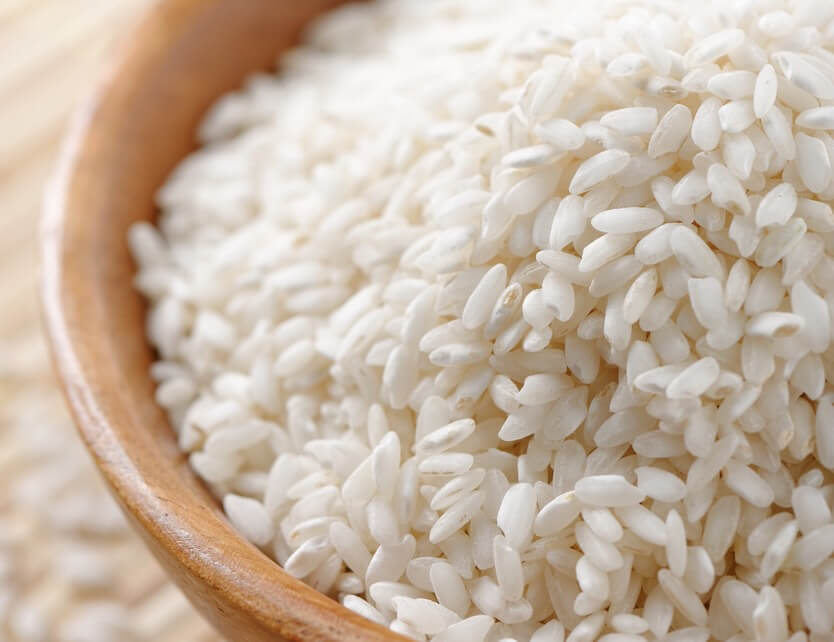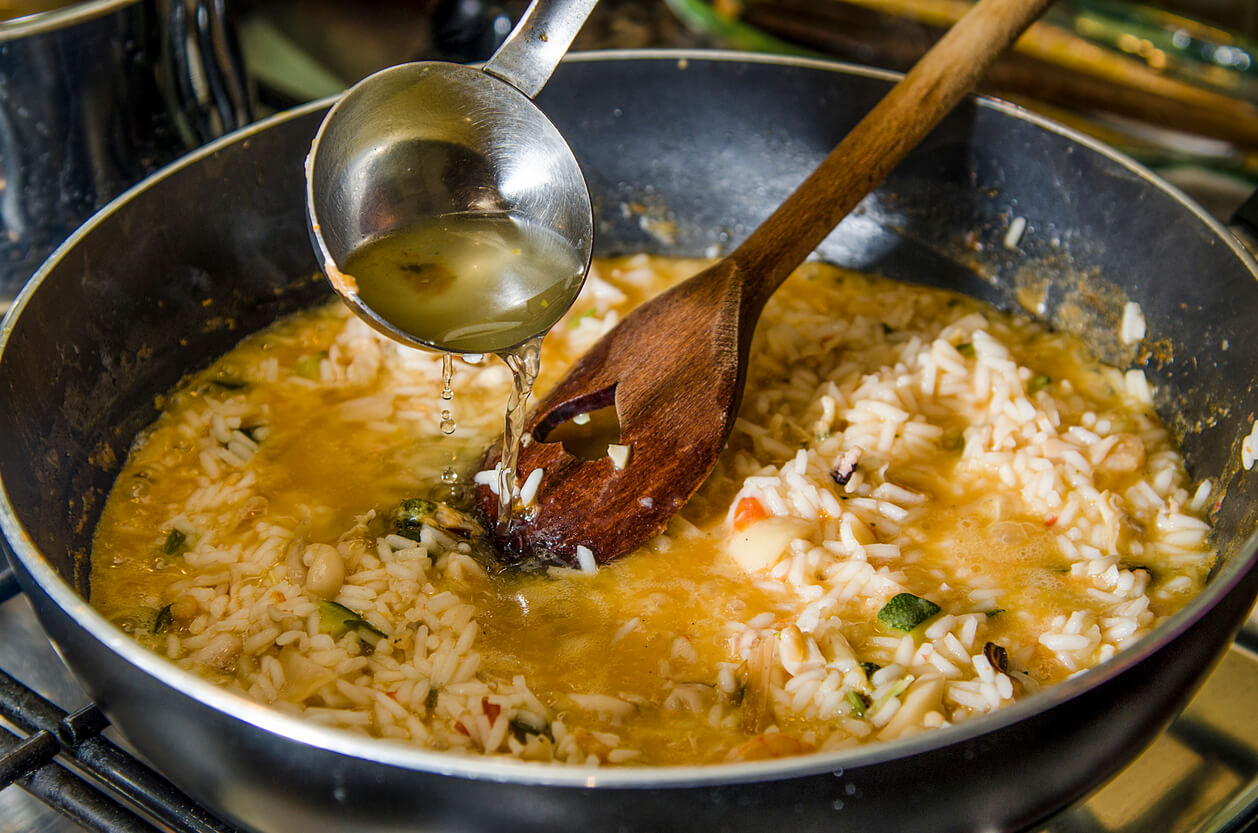Ever heard the Italian saying that someone who laughs easily “has eaten rice soup”? Risotto has long been seen as a dish that lifts both spirit and appetite. Though it might look like fancy restaurant food, risotto’s true beauty is how approachable it is: silky grains with just the right bite, enveloped in a creamy, soul-warming sauce.
A technique as well as the name of a dish, risotto does demand attention, but the secrets to those dreamy results are simpler than you might think. And it’s one of those recipes that is worth reading and understanding before you start. Once you get the rice, stirring technique, broth choice, and timing right, you can create restaurant-quality risotto at home, complete with a sense of accomplishment (and maybe even a laugh or two).
From Northern Italy with Love
Risotto was first made in Northern Italy, where fertile plains and endless rice paddies shimmer across regions like Lombardy, Piedmont, and Veneto.
Unlike simple boiled rice, risotto is defined by its method: grains are slowly simmered in a warm broth while being stirred just enough to coax out their natural starches. The result is a silky, spoonable dish with a luxe texture that feels far greater than the sum of its parts.
Over the centuries, Italians have developed countless variations. Risotto alla Milanese, golden with saffron, is perhaps the most famous. Venice is known for seafood versions that capture the flavors of the lagoon and the surrounding Adriatic Sea, while Piedmont’s forests inspire earthy mushroom risotti. No matter the style, risotto remains one of Italy’s most comforting culinary gifts, and proof that patience and simple ingredients can create something extraordinary.

Short-grain rice like Arborio or Carnaroli is the key to risotto’s creaminess.
What Makes Risotto Different from Regular Rice?
Like many deceptively simple dishes, risotto depends on both the right ingredients and an understanding of how they work together. At the heart of it all is the rice itself, and short and starchy is the name of the game here.
- Carnaroli: The chef’s favorite. Its grains stay firm while still releasing plenty of starch, making it both forgiving and luxuriously creamy.
- Vialone Nano: Smaller, delicate grains that yield a silkier, lighter risotto. Especially prized in the Veneto region.
- Arborio: The most common risotto rice in U.S. grocery stores. It creates a rich, thick texture but can turn mushy if cooked too long.
So why not use long-grain rice, like basmati or jasmine? It comes down to starch chemistry. Rice contains two main starches: amylose and amylopectin. Long-grain rice has more amylose, which makes it cook up fluffy and separate—ideal for pilaf, but terrible for risotto. Short-grain rice, on the other hand, is loaded with amylopectin, the starch that breaks down and creates risotto’s signature creaminess.
Why texture matters: A proper risotto should gently spread on the plate, glossy and creamy, with grains that are tender yet still have a slight chew. If it’s clumpy or dry, something went wrong along the way.
Quick Guide to Risotto Rices
| Rice Type | What It Looks Like | Where It Comes From | Best For | STexture Notes |
|---|---|---|---|---|
| Arborio | Short, fat, pearly grains | Po Valley, Northern Italy | Beginners; most widely available | Creamy but can get mushy if overcooked |
| Carnaroli | Medium-long, plumper grains | Lombardy & Piedmont, Italy | Home cooks who want chef-level results | Very creamy, stays firm, more forgiving |
| Vialone Nano | Small, rounded grains | Veneto, Italy | Light, delicate risottos (seafood, veggies) | Silky, less heavy than Arborio or Carnaroli |
| Bomba (Paella rice) | Short, round grains | Valencia, Spain | Paella; acceptable substitute if can’t find others | Absorbs lots of liquid, less creamy |
| Not for Risotto | Long, slender grains (basmati, jasmine); parboiled rice | Various regions | Pilaf, plain rice dishes | Stay separate, don’t release enough starch for creaminess |
Building Flavor from the Start
Risotto’s flavor begins long before the first ladle of broth. It starts with simple aromatics of onion and garlic gently sautéed in butter or olive oil until soft and fragrant. This aromatic base adds sweetness and depth, preparing the rice for the next crucial step: tostatura, or toasting the rice. By stirring the dry grains into the hot pan, each kernel becomes coated in fat and lightly toasted, giving the finished dish a subtle nuttiness.
Once the rice is warm and glistening, a splash of wine comes in to deglaze the pan. Traditionally, white wine is used for its crisp acidity. This moment of acidity balances the richness that will follow. If you’d rather not use wine, a little lemon juice stirred in at the end can achieve a similar brightness.
Chef’s Tip: Choosing the Right Wine
- Reach for dry white wines like Pinot Grigio, Sauvignon Blanc, or unoaked Chardonnay. Their crisp acidity balances risotto’s richness without overpowering it.
- Avoid sweet wines (like Moscato or Riesling), which can throw off the flavor balance.
- Cooking without wine? Add a squeeze of lemon juice at the end for brightness.
The Broth: The Heart of Flavor
If rice provides risotto’s structure, the broth gives it soul. Every ladleful you add cooks the grains, while also infusing them with flavor and creating the silky sauce that makes risotto so beloved. Always keep your broth hot; adding cold broth can “shock” the rice, slowing the cooking time and leaving you with unevenly cooked grains.
The type of broth you choose can completely change the mood of the dish.
- Chicken stock brings classic savory richness, perfect for a cozy comfort dish.
- Vegetable stock offers a lighter, cleaner taste that’s ideal for spring and summer risottos.
- Seafood stock is good for seafood variations, naturally, like mussels, shrimp, or scallops, offering a briny depth that ties everything together.
- Mushroom stock is perfect for creating an umami-rich base if you want to lean into cozy, earthy flavors.
As you cook, keep a ladle at the ready. The goal isn’t to drown the rice but to let it sip slowly, absorbing just enough liquid before you add the next pour.
And here’s a small but mighty tip: always taste your warm broth before you begin. If it’s already salty, you’ll need to hold back on seasoning the final dish to avoid an overwhelming finish. You can also dilute it with a little bit of water if you need, especially if you plan to add other salty ingredients, like Parmesan, at the end.

Adding hot broth gradually helps the rice release starch for a silky sauce.
Stirring Technique: Finding the Balance
One of the first things you’ll hear about risotto is that you have to stir nonstop. In reality, stirring matters, but it’s about rhythm, not constant motion. Each time you move the grains gently against one another, they release starch, which thickens the sauce into its creamy consistency. Stirring also prevents sticking and keeps the rice cooking evenly.
Aim for a steady approach. Give the risotto a stir every minute or so, letting it rest in between stirs to absorb the liquid. Traditionally, broth is added one ladle at a time, but if you prefer a more relaxed method, use a wide, shallow pan and add more broth at once. The larger surface area helps liquid evaporate evenly, so you can stir less and still get creamy results.
When the risotto is ready, usually after 20–30 minutes, the grains should be tender with just a hint of chew, and the mixture should flow slowly across the pan like warm lava, neither stiff nor soupy.
Chef Curtis Duffy demonstrates how to make a classic risotto.
Common Mistakes to Avoid
Even seasoned cooks can stumble with risotto. It’s a dish that rewards attentiveness and punishes those who want to move along too quickly. Here are some pitfalls to watch out for:
- Starting with cold broth. Adding chilled liquid halts the cooking process and leaves the rice unevenly cooked. Always keep your broth hot and ladle it in gradually.
- Skipping the toasting step. Briefly toasting the rice in butter or oil alongside the soffritto builds a nutty base flavor and helps the grains hold their shape. Without it, risotto can taste flat and mushy.
- Overloading the pot too soon. It’s tempting to toss in all your vegetables, meats, or seafood right away, but doing so can muddy flavors and slow down the rice’s absorption. Save delicate add-ins for the final minutes.
- Overcooking. Perfect risotto should be creamy yet still have a pleasant bite in the center of each grain. Start tasting after 15 minutes and pay close attention to flavor and texture. If the rice begins to look soupy or collapse into a paste, it’s gone too far.
- Making it too early. Risotto doesn’t like to wait. It continues to thicken as it cools, so serve it immediately after cooking. If it seems too stiff, revive it with a splash of hot broth before plating. Alternatively, risotto can be cooked to 80% done, spread on a sheet pan to chill, then finished in a saute pan to order. Professional kitchens prepare it this way instead of cooking it to order.
Handled with care, risotto is forgiving enough to let you adjust along the way, so you can avoid these common missteps and serve up something silky and satisfying.
Simple Creamy Risotto Recipe
Ingredients:
- 1 ½ cups Arborio (or Carnaroli if available)
- 4 cups chicken or vegetable broth (kept warm)
- 2 tbsp butter (divided)
- 1 tbsp olive oil
- 1 small onion, finely chopped
- 2 garlic cloves, minced
- ½ cup dry white wine
- 1 cup freshly grated Parmesan cheese
- Salt and pepper, to taste
Instructions:
- Heat broth in a saucepan and keep warm.
- In a large skillet or saucepan, melt 1 tbsp butter with olive oil. Add onion and sauté until translucent, about 3 minutes. Add garlic and cook briefly.
- Stir in rice and toast for 2–3 minutes until edges look translucent.
- Pour in wine; stir until mostly absorbed.
- Add hot broth one ladle at a time, stirring often. Wait until absorbed before adding more. Continue until rice is al dente and creamy, but start tasting at 15 minutes.
- Remove from heat. Stir in remaining butter and Parmesan. Adjust seasoning.
- Serve immediately.
From Technique to Comfort at the Table
Risotto is less about perfection and more about patience. By practicing, you’ll start to recognize the visual and textural cues of a good risotto without even thinking about it. Once you’re comfortable with the basic technique, try building on it. Fold in roasted squash and sage for fall, add seafood to echo the flavors of the sea, or stir through a spoonful of herb pesto for a fresh finish.
In the end, risotto rewards cooks who are willing to stand at the stove, taste as they go, and make small adjustments along the way. It’s a dish that teaches you to cook with your senses engaged—and when you get it right, the result is a bowl of pure comfort worth every minute of attention.
Hungry for more? Try these articles next:

